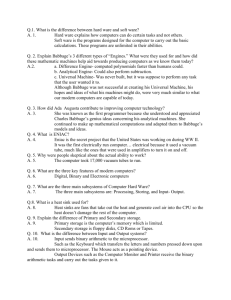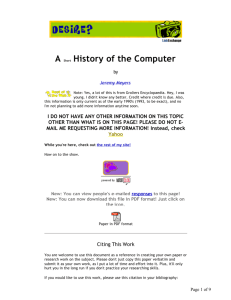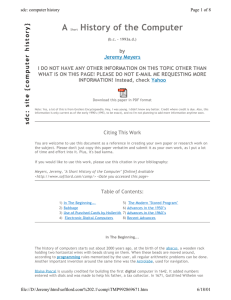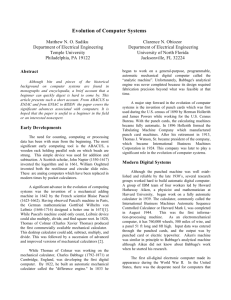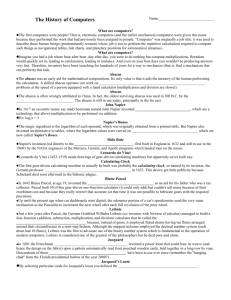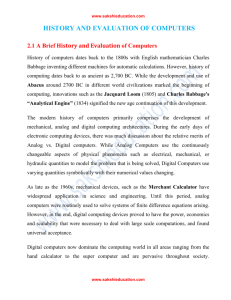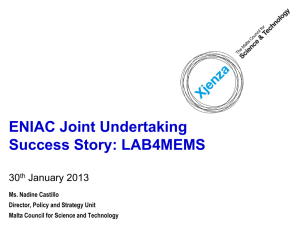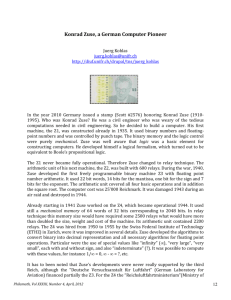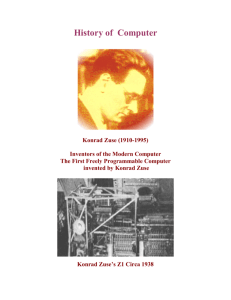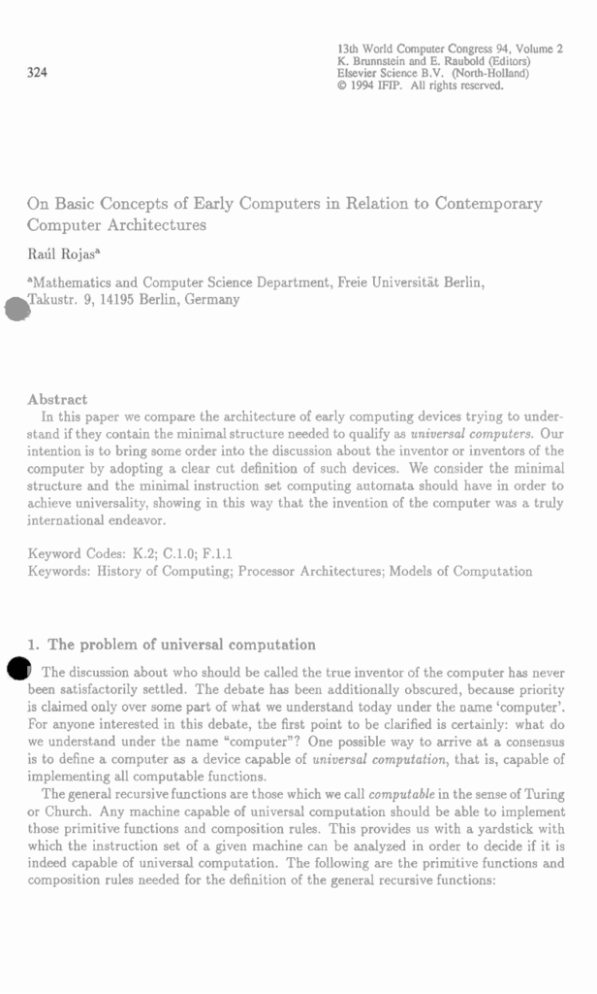
131hWorld Computer Congress 94, Volume 2
K. Bmnnslein and E. Raubold (Editors)
Elsevier Science B.V. (Nonh-Holland)
63 1994 IFIP. All rights reserved.
On Basic Concepts of Early Computers in Relation to Contemporary
Computer Architectures
'Mathematics and Computer Science Department, Freie Universität Berlin,
Takustr. 9, 14195 Berlin, Germany
e
Abstract
In this paper we compare the architecture of early computing devices trying to understand if they contain the minimal structure needed to qualify as universal computers. Our
intention is to bring some order into the discussion about the inventor or inventors of the
computer by adopting a clear cut definition of such devices. We consider the minimal
structure and the minimal instruction set computing automata should have in order to
achieve universality, showing in this way that the invention of the computer was a truly
international endeavor.
Keyword Codes: K.2; C.l.O; F.1.1
Keywords: History of Computing; Processor Architectures; Models of Computation
1. The problem of universal computation
The discussion about who should be called the true inventor of the computer has never
been satisfactorily settled. The debate has been additionally obscured, because priority
is claimed only over some part of what we understand today under the name 'computer'.
For anyone interested in this debate, the first point to be clarified is certainly: what do
we understand under the name "computer"? One possible way to arrive at a Consensus
is to define a computer as a device capable of universal computation, that is, capable of
irnplementing all computable functions.
The general recursive functions are those which we call computable in the sense of Turing
or Church. Any machine capable of universal computation should be able to implement
those primitive functions and composition rules. This provides us with a yardstick with
which the instruction set of a given machine can be analyzed in order to decide if it is
indeed capable of universal computation. The following are the primitive functions and
composition rules needed for the definition of the general recursive functions:
zero function
successor
projection
P;(xI,..-,x~) X i
function composition f o g(x) = f (g(x))
primitive recursion
4(O, xz, ...,X,) = $(x2,. . .,X,,)
, . .>X,), Y, 5 2 9 . .
4(y1,5 2 , . . 7 2,) = x ( ~ ( Y52,.
p operator
P [ P ( ~=
) OI
.,xn)
The U, operator is the minimization function which for a function P gives the minimal
value of t complying with P ( t ) = 0. Primitive recursion is defined in the usual way.
These functions can be implemented in a computing machine with a Single accumulator
by providing the following primitive instructions and sequencing rules:
0
zero function
CLR
INC
projection
LOAD address
function composition inst A
inst B
primitive recursion
FOR i=O to n
operator
WHILE (condition) D 0
SUCC~SSO~
The CLR instruction sets the accumulator to zero, INC increments it by one and LOAD
deposits the contents of the cell at location 'address' into the accumulator. Since the p
operator works implicitly with a table of function values it is also necessary to provide
some kind of indirect addressing in the machine. Otherwise, it is not possible to access
nurnerical tables of variable length. Tuple formation, included implicitly in the definition
of functions like f (xi, x2, . . . ,X,) requires an additional STORE instruction to build those
tuples (or tables) in memory.
The FOR and WHILE loops can be implemented in a simpler manner by providing
some kind of conditional branch in the machine.
General-purpose programming languages implement iterative calculations over tables
of numbers by providing indexed arrays. At the machine level some kind of indirect
addressing is required to retrieve the elements of an array from memory. There are two
ossible solutions to this problem. The f i s t is to make the LOAD instruction introduced
bove retrieve its parameter from a register in the processor. If we want to load the
contents of address 100 to the accumulator, we first set the special register to 100 and
we then load the address pointed to by this register. This requires additional hardware
and a more sophisticated instruction decoding. The second is cheaper and is in fact the
one which was used in early computers: Just store the program in memory and let the
LOAD instruction work only with a constant argument. Since the prograrn is stored in the
memory of the machine, all instructions can be modified by the program being executed.
A self-modifying prograrn can store the code for the instruction "LOAD 100" or "LOAD
200" in the required address, and when this address is executed, the effect is the Same as
if we had provided a register for indirect addressing.
The Same strategy can be used in order to define procedure calls. Instead of introducing
a CALL instruction, an unconditional branch to the the code of the procedure is executed,
but before doing this an unconditional branch back to the main code is inserted at the
S
end of the procedure's code. In this way the procedure is automatically threaded with
the main program. This techniques were used in the University of Manchester's Mark 1
computer, universally acclaimed as the first one to provide memory stored programs [7].
2. Early computing machines
In this section we consider the architecture of several machines and we will be looking
for the instructions CLR, INC, LOAD, STORE, conditional branches and indirect addressing (or equivalently self-modifying programs), when trying to decide if a particular
implementation can be called a universal computer.
2.1. T h e architecture of t h e Z l
The Z1 was developed by the Gerrnan engineer Konrad Zuse from 1936 to 1938 i
p
Berlin (Figure 1). It was a mechanical computer, but it was not built with rotating
like many of the calculators used at the time. It used instead sheets of meta1 capable of
controlling binary switches used to store binary digits and to pedorm logical operations
[6]. This is indeed the first interesting characteristic of this machine. Whereas other
computers worked with a decimal representation even years after the Z1 was completed,
Zuse's choice of the binary system allowed him to keep the the machine under a certain
complexity level.
punched tape
.... ...
FPacumrnulstor
22 bis wide
Figure 1. Logical structure of the Z1
As can be Seen in Figure 1, the Z1 was capable of computing the four elementary
arithmetic operations as well as the Square root of numbers. The program was punched on
a film tape and was read sequentially by a tape reader. Besides the arithmetic operations
there was an instruction for reading a number from a keyboard and storing it in aay oi
64 memory cells, as well as an instruction for showing the contents of the accumulator of
the machine in a field of electric lamps. Years before John von Neumann explained the
advantages of a computer architecture in which the processor has been logically separated
from the memory, Zuse had already arrived to the Same conclusions. Another interesting
feature of the Zl was its use of a floating-point representation. Each number was stored
as a mantissa, an exponent and a sign. The processor computed all arithmetic operations
using this coding (called by Zuse logarithmic representation) [ll].It would be more than
fifteen years before someone built another machine with floating-point registers.
The Z1 lacked conditional or unconditional branches. It could not deal with indexed
arrays of numbers and since the program was stored externally no self-modifying code
was possible. The Z1 was nevertheless the first program controlled calculating device ever
built. Its claim to fame lies in this fact.
rn
.
2.2. Atanasoff's machine
John Atanasoff built his electronic computer at the University of Iowa from 1938 to 1942.
His machine stands as a technological feat of simplicity. Whereas all other computing
machines developed at the time worked with parallel arithmetic hardware, Atanasoff
decided to use a serial approach. Two rotating drums (Figure 2) stored up to thirty fixedpoint numbers. Each number was stored in one sector of the drum using 50 capacitors,
that is, 50 bits. The machine could thus hold at any time just two different vectors in its
30 30 memory cells. The vectors were read in decimal form frorn punched cards and
were transformed to binary numbers before being stored. Atanasoff designed his machine
in order to solve systems of linear equations with up to 29 variables. Since the machine
worked with Gauss reduction, one of the vectors was used repetitively to reduce the other.
n h e leading coefficient of the other vector was reduced to Zero through a combination of
dditions, subtractions and shifts. The result was stored in a paper card and the next
vector was loaded. Through a combination of manuai and automatic operations, large
matrices could be reduced to a triangular form.
+
I
suial adcierloubtniccer
50 bits
card punch
Figure 2. Logical Structure of the ABC
Since the drums rotated once every second, all bits of corresponding vector elements
could be read sequentially and could be fed into a serial adder whose result could be
f?ritten back to one of the drums. The adder could be implemented with a minimum
of hardware by recycling the carriage ,bit. The adder could Aso subtract one number
from another, if this was desired. A logical shift of a binary number was nothing but
a read and write operation with a specific delay. There was an adder for each vector
element. It would be 1948 before the Manchester tearn in charge of building a cornputer
would rediscover serial arithmetic and ail its benefits regarding the minimization of the
hardware needed.
The ABC (Atanasoff-Berry-Computer, as it was called) was a speciai purpose machine,
lacking any kind of external prograrnming feature ("soft prograrnming"). It could only be
used to solve systems of linear equations. There was a clear Separation between processor
and memory, but the processqr was not sophisticated enough. The ABC can be called the
first array processor of the world and as such it would have been of use as an extension
or coprocessor to a universal computer, but could not have replaced this one.
2.3. T h e architecture of Mark I
The Mark I was built by Howard Aiken at Harvard University from 1939 to 1944.
Like Atanasoff, Aiken was a physicist anxious to create a machine capable of doing the
extensive calculations that he needed. The Mark I was an eledromechanical machine, a
kind of hybrid between the all-mechanical nature of previous wmputing devices and the
electronics available at the time. Figure 3 shows a diagram of the fundamental building
blocks of Aiken's machine.
aecumulator I
P ~ C tape
M
."
."
0
I
......
X
."
.".
"
readmg unii
sequenca
- 2
accmulaior2
...
,
,
u
u
,
+
W M ~ I I
+constant2
...
m t a n t 60
multiplier
divider
spcial hinctions
Figure 3. Logical Structure of the Mark I
Aiken used a decimal representation for storage. Rotating gears were used to store and
transmit the numbers in the memory. There was no sharp distinction between processor
and memory, since each of the 72 memory cells was an accumulator capable of adding
or subtracting a given fixed-point number. Each accumulator could transmit its contents
through what we would today call a bus to other accumulators. There were also Special
units which stored tables of numbers and a multiplier. Sixty storage words could be set
manually by the operator and constituted the constants in a program. The program itself
was stored on punched paper tape, and two reading units made possible the execution in
parallel of two programs or of the Same one (for checking purposes). The Mark I used
what we now call a three-address format for its instructions. Ail elementary arithmetic
operations were possible, as well as sequencing of instructions.
6
'
Aiken's Mark I was not a universal computer since it lacked conditional branches. 1,
was possible to repeat a section of code a given number of times, but no conditional
execution of loops was possible. Since the program was stored externally, self-modifying
code could not be implemented.
2.4. T h e ENIAC
The ENIAC (acronym for Electronic Nvmerical Integrator and Computer) was built at
the Moore School of Electrical Engineering of the University of Pennsylvania from May
1943 to 1945. It solved its first problem in December 1945 and was officiaily presented
in February 1946. The project was conceived originally as an electronic realization of the
analog differential analyzers used at the time for the Same purpose. The ENIAC has often
been hailed in the popular literature as the first computer of the world.
From the viewpoint of computer architecture the ENIAC was a parallel dataflow ma-
itting its wntents to any of the other accumulators, or of receiving a number and adding
to its stored content. There was a multiplying and a dividing unit. Since the machine
. Rotating gears were used to store arid
no sharp distinction between processor
was an accumulator capable of adding
accumulator could transmit its wntents
+
If it was desired to perform a calculation like ab C it was necessary to connect two
cumulators to the multiplying unit. One of the arguments was received f i s t and the
r was transmitted later. The output of the multiplying unit could be added with the
thus capable of implementing the CLR operation (since each accumulator could be
t to Zero on demand), addition, load and store of numericai data. The ENIAC was
capable of implementing primitive recursion since a special unit, called the master
valent to a FOR loop in a high-level language. More important was the ability of the
ter controller to stop a given computational thread when a given quantity changed
s sign. In this way it was also possible to implement WHILE laops and conditional
ranches in the machine.
The ENIAC stopped short a being a universal computer, not because the program
as hardwired, but because it depended on a single master controller. Conditional loops
ere only possible at the highest control level and conditional bbrnches consisted solely
sible to arrange for a hierarchical control mechanism consisting of multiple master
trollers, but this was never done in practice [3]. Indirect addressing was clearly imsible, since memory and control were intertwined. Self-modifying programs were also
2.5. T h e Analytical Engine
Finally, we must consider the design of the Analytical Engine conceived by Charles
Babbage in the nineteenth century. The architecture of Babbage's machine is surprisingly
modern. It includes such features as a clean logical separation of numerical storage and
processor, a microprogrammed computing unit and even a pipelined design! [2]. Babbage
worked on the Analytical Engine from 1834 until his death in 1871.
sequencerand
micmprogram
data
I Output devices I
punched
cards
instnic~om
Figure 5. Logical Structure of the Analytical Engine
Figure 5 shows the main building blocks of the machine. Each number was stored in
a vertical stack of rotating wheels using a decimal representation. The contents of each
storage unit wuld be transported to the processor of the machine, called by Babbage "the
mill". The four basic arithmetic operations were implemented in the mill. The program
was read from punched cards, similar to the ones used in the Jacquard looms. Another
set of cards contained the data for the program. This separation of code and data was a
clever way of eluding the problem of indexed addressing. Since Babbage's machine could
implement loops, it was possible to repetitively read the code cards at the Same time as
new data cards were sequentially fed into the machine. Long tables could be calculated
in this way.
In his design Babbage also included the possibility of conditional branching. The reading units should work bidirectionally in order to make this possible. The machine should
have also sophisticated output devices, like a machine capable of producing the lead plates
needed to print the calculated numerical data or even what we would call today a p l o t t n
Nevertheless the machine lacked any kind of indirect addressing. Babbage was aware L.
the restrictions imposed by an external program. Because of this, he speculated with the
idea of including a card puncher as an output option. The machine could in this way
produce its own programs.
3. Architectural comparison
As should be clear from the descriptions given above, no Single machine fulfills all the
necessary requirements for a universal computer. The Analytical Engine is surprisingly
the one which Comes closest. Had Babbage indeed built into his machine the possibility
of punching his own code-cards, his wouid have been a real computer. The tables show
the main features of the machines we analyzed. We also include the Mark 1 machine built
at Manchester from 1946 to 1948, because as far as we know this was the first machine
to fit our definition of a universal computer. The Mark 1 was built under the direction of
F.C. Williams and T. Kilburn. This machine stored its program in random-access digital
memory implemented with CRS tubes. All necessary instruction primitives were available
(in modified form), and although it lacked indirect addressing, self-modifying programs
could be written [7].
Machine
rnernory and
CPU separated?
conditional
branching?
J
d
J
J
X
X
X
partially
J
d
Babbage's
Zuse's Z1
Atanasoff's
H-Mark I
ENIAC
M-Mark 1
Machine
Babbage's
Zuse's Z1
Atanasoff's
H-Mark I
ENIAC
M-Mark 1
internal
coding
decimal
binary
binary
decimal
decirnal
binary
X
X
fixed-point or
floating-point?
fixed-point
floating
fixed-point
fixed-point
fixed-pokt
fixed-point
soft or hard
prograrnming
soft
soft
hard
soft
hard
soft
sequential
logic?
no
no
yes
no
no
yes
self-modifying . indirect
programs?
addressing?
planned
X
X
X
X
X
X
X
X
X
J
X
architecture
technology
pipelined
sequential
vectorizd
parallel'
data flow
sequential
rnechanical
mechanical
electronic
electromechanical
electronic
electronic
The ENIAC was the fastest machine in its time and could implement loops, but lacked
any kind of soft programming. Atanasoff's machine was the first electronic calculating
engine. Although the Mark 1 from Manchester was indeed a universal wmputer, it would
be hard to credit its designers with having invented the computer single-handedly, since
some of the design ideas were taken from the EDVAC project conceived by the ENIAC
creators and John von Neumann. In fairness it should be concluded that the invention
of the computer Spans a period of more than hundred years, in which scientists from
at least three different countries provided the theoretical and practical foundations for
this enterprise. If there is a technological achievement in which only international crossfertilization could have led to success, then the invention of the computer is indeed one.
REFERENCES
>.H. Aiken and G. Hopper. "The Automatic Sequence Controlled Calculator", reprinted in [9], pp,
203-222.
2. A. Bromley, "The Evolution of Babbage's Calculating Engines", Annals of the Hastory of Computing,
Vol. 9, N. 2, 1987, pp. 113-136.
3. A. W.Burks and A. R. Burks, 'The ENIAC: First General-Purpose Electronic Computer", Annals
of the Hrstory of Computing, Vol. 3, N . 4, 1981, pp. 310-399.
4. A. W. Burks and A. R. Burks, The First Electronic Computer, The University of Michigan Press,
Ann Arbor, 1988.
5. B. Collier, The Little Engrnes that Could've, Garland Publishing, Inc., New York, 1990.
6. K.-H. Czauderna, Konrad Zuse, der Weg zu setnem Computer ZS,Oldenbourg Verlag, Munich, 1979.
7. S.H.Lavington, A htstory of Manchesfer computers, NCC Publications, Manchester, 1975.
8. Early Bniish Computers, Digital Press, Manchester, 1980.
9. B. Randell, The Ongins of Digiial Computers, Springer-Verlag, Berlin, 1982.
10. N. Stern, From ENIAC to UNIVAC, Digital Press, Bedford, 1981.
11. K. Zuse, Der Computer - mean Lebenswerk, Springer-Verlag, Berlin, 1970.


